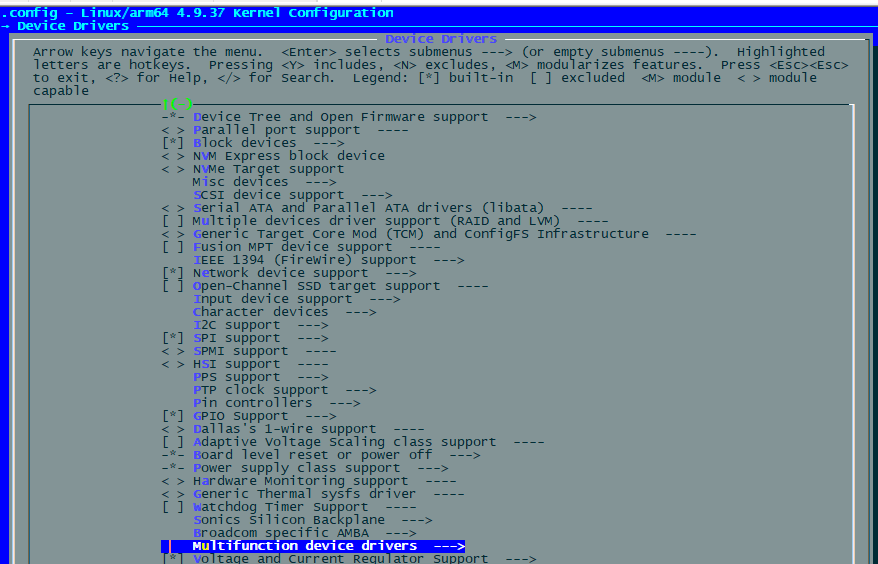多功能设备mfd驱动
一、概述
mfd是Multifunction device的简称,即多功能设备,是许多有共性的设备的集合,mfd由核心层(core)以及其下的“子设备”组成。从下文将会看到,mfd只是将设备注册到platform总线——因此,其子设备属于platform设备。它并没有对涉及到的设备或驱动做实质性改变。但是,因为某些设备的共性,所以可以在mfd中提供共同的函数给其下子设备进行调用。
本文提到的hisi_fmc驱动就是如此:
下面就分析mfd设备注册过程,并结合1个实例讲解。
内核配置(make menuconfig)信息如下:

在里面可以选中自己需要的器件;
.config文件中配置CONFIG_MFD_CORE=y
二、mfd设备添加
mfd核心代码位于drivers/mfd/mfd-core.c文件中。对外提供添加设备和删除设备的接口:mfd_add_devices、mfd_remove_devices。设备添加函数原型如下:
int mfd_add_devices(struct device *parent, int id,
const struct mfd_cell *cells, int n_devs,
struct resource *mem_base,
int irq_base, struct irq_domain *domain)
- id:即设备ID号。它指示着设备的个数。一般可以设置为-1。即表示系统有且仅有一个这样的设备。如果有多个foo设备,则需要使用id来区别。
在/sys/bus/platform/devices目录下会产生foo.0,foo.1等设备。详情可以看platform设备添加函数过程。
cells:即mfd_cell结构体数组,n_devs为其数组大小,即设备数量。
mem_base:资源resource结构体。如果没有,可置为NULL。
描述mfd设备单元称为“cell”,mfd_cell定义如下:
/*
* This struct describes the MFD part ("cell").
* After registration the copy of this structure will become the platform data
* of the resulting platform_device
*/
struct mfd_cell {
const char *name;
int id;
/* refcounting for multiple drivers to use a single cell */
atomic_t *usage_count;
int (*enable)(struct platform_device *dev);
int (*disable)(struct platform_device *dev);
int (*suspend)(struct platform_device *dev);
int (*resume)(struct platform_device *dev);
/* platform data passed to the sub devices drivers */
void *platform_data;
size_t pdata_size;
/*
* Device Tree compatible string
* See: Documentation/devicetree/usage-model.txt Chapter 2.2 for details
*/
const char *of_compatible;
/*
* These resources can be specified relative to the parent device.
* For accessing hardware you should use resources from the platform dev
*/
int num_resources;
const struct resource *resources;
/* don't check for resource conflicts */
bool ignore_resource_conflicts;
/*
* Disable runtime PM callbacks for this subdevice - see
* pm_runtime_no_callbacks().
*/
bool pm_runtime_no_callbacks;
/* A list of regulator supplies that should be mapped to the MFD
* device rather than the child device when requested
*/
const char * const *parent_supplies;
int num_parent_supplies;
};
部分常见的成员介绍如下:
- name:设备平台。
- platform_data:平台私有数据指针,数据大小使用pdata_size表示。
- resources:资源结构体,资源数量使用num_resources表示。
- ignore_resource_conflicts:为true表示不检查资源冲突。
- of_compatible:设备树匹配compatible的字符串(具体参考
Documentation/devicetree/usage-model.txt Chapter 2.2)这个根据我的理解,是用于platform device的,只是写在了mfd设备上;
至此,mfd设备的添加就完成了,最终调用驱动的probe函数。从这个过程中知道,mfd实质上就是封装一个接口,将一些可以归纳到一起的platform设备注册到platform总线上。它就是一个收纳盒子。里面的设备该是怎样处理就怎样处理。
三、mfd实例
下面介绍hisi_fmc驱动的实例:
static int hisi_fmc_probe(struct platform_device *pdev)
{
struct hisi_fmc *fmc;
struct resource *res;
struct device *dev = &pdev->dev;
int ret;
pr_err("hisi_fmc_probe successfully!\n");
fmc = devm_kzalloc(dev, sizeof(*fmc), GFP_KERNEL);
if (!fmc)
return -ENOMEM;
res = platform_get_resource_byname(pdev, IORESOURCE_MEM, "control");
fmc->regbase = devm_ioremap_resource(dev, res);
if (IS_ERR(fmc->regbase))
return PTR_ERR(fmc->regbase);
res = platform_get_resource_byname(pdev, IORESOURCE_MEM, "memory");
fmc->iobase = devm_ioremap_resource(dev, res);
if (IS_ERR(fmc->iobase))
return PTR_ERR(fmc->iobase);
fmc->clk = devm_clk_get(dev, NULL);
if (IS_ERR(fmc->clk))
return PTR_ERR(fmc->clk);
if (of_property_read_u32(dev->of_node, "max-dma-size", &fmc->dma_len)) {
dev_err(dev, "Please set the suitable max-dma-size value !!!\n");
return -ENOMEM;
}
ret = dma_set_mask_and_coherent(dev, DMA_BIT_MASK(32));
if (ret) {
dev_warn(dev, "Unable to set dma mask\n");
return ret;
}
fmc->buffer = dmam_alloc_coherent(dev, fmc->dma_len,
&fmc->dma_buffer, GFP_KERNEL);
if (IS_ERR(fmc->buffer))
return PTR_ERR(fmc->buffer);
mutex_init(&fmc->lock);
platform_set_drvdata(pdev, fmc);
ret = mfd_add_devices(dev, 0, hisi_fmc_devs,
ARRAY_SIZE(hisi_fmc_devs), NULL, 0, NULL);
if (ret) {
dev_err(dev, "add mfd devices failed: %d\n", ret);
return ret;
}
return 0;
}
- 读取fmc的reg_base、io_base;
- 获取最大的
max-dma-size - 添加mfd设备
ret = mfd_add_devices(dev, 0, hisi_fmc_devs,
ARRAY_SIZE(hisi_fmc_devs), NULL, 0, NULL);
多功能设备mfd驱动的更多相关文章
- i2c总线,设备,驱动之间的关系
------ 总线上先添加好所有具体驱动,i2c.c遍历i2c_boardinfo链表,依次建立i2c_client, 并对每一个i2c_client与所有这个线上的驱动匹配,匹配上,就调用这个驱动的 ...
- linux设备驱动归纳总结(九):1.platform总线的设备和驱动【转】
本文转载自:http://blog.chinaunix.net/uid-25014876-id-111745.html linux设备驱动归纳总结(九):1.platform总线的设备和驱动 xxxx ...
- linux设备驱动归纳总结(八):1.总线、设备和驱动【转】
本文转载自:http://blog.chinaunix.net/uid-25014876-id-109733.html linux设备驱动归纳总结(八):1.总线.设备和驱动 xxxxxxxxxxxx ...
- Linux下实现流水灯等功能的LED驱动代码及测试实例
驱动代码: #include <linux/errno.h> #include <linux/kernel.h> #include <linux/module.h> ...
- platform总线,设备,驱动的注册
linux设备驱动归纳总结(九):1.platform总线的设备和驱动 xxxxxxxxxxxxxxxxxxxxxxxxxxxxxxxxxxxxxxxxxxxxxxxxxxxxxxxxxxxxxxxx ...
- SPI设备的驱动
主要包括两个SPI设备步骤:register_chrdevspi_register_driver关键点1:spi_board_info可以去已经运行的板子下面找例子:/sys/bus/spi/driv ...
- I2C总线、设备、驱动
I2C总线.设备.驱动 框架 I2C驱动框架可分为3个部分,分别是:I2C核心层.I2C总线驱动层(适配器层)以及I2C设备驱动层: I2C核心层 提供了统一的I2C操作函数,主要有两套函数smbus ...
- 【Linux开发】linux设备驱动归纳总结(九):1.platform总线的设备和驱动
linux设备驱动归纳总结(九):1.platform总线的设备和驱动 xxxxxxxxxxxxxxxxxxxxxxxxxxxxxxxxxxxxxxxxxxxxxxxxxxxxxxxxxxxxxxxx ...
- 【Linux开发】linux设备驱动归纳总结(八):1.总线、设备和驱动
linux设备驱动归纳总结(八):1.总线.设备和驱动 xxxxxxxxxxxxxxxxxxxxxxxxxxxxxxxxxxxxxxxxxxxxxxxxxxxxxxxxxxxxxxxxxxxxxxxx ...
随机推荐
- mysql数据库的安装与配置
mysql数据库的安装与配置及workbench的简单使用 mysql数据库社区版下载:https://dev.mysql.com/downloads/installer/ 我这里选的是社区安装版(适 ...
- ROC曲线的计算
1.ROC曲线简介 在评价分类模型时,会用到ROC(receiver operating characteristic)曲线.ROC曲线可用来评价二元分类器( binary classifier)的优 ...
- 一个相对健壮的node 静态http服务器
先上代码,然后说说坑,算是一个总结,以后在mac上就用这个开启服务调试了,挺好.然后接着想写一个动态的返回页面的,刚好练手mv*的框架. var http = require('http'); var ...
- 在线OJ的小demo
牛课网OJ规则 用readLine()代替read_line() 用readLine()代替read_line() 用readLine()代替read_line() 用readLine()代替read ...
- sublime安装AngularJS插件
sublime能够支持AngularJS开发那绝对是一件很爽的事情.下面我一步步讲解如何为sublime安装AngularJS插件. 1.添加控制包站点 根据你安装sublime 版本不同,在控制台写 ...
- spring MVC 管理HttpClient---实现在java中直接向Controller发送请求
在spring MVC中,大多数时候是由客户端的页面通过ajax等方式向controller发送请求,但有时候需要在java代码中直接向controller发送请求,这时可以使用HttpCilent实 ...
- Python定时任务
在项目中,我们可能遇到有定时任务的需求.其一:定时执行任务.例如每天早上 8 点定时推送早报.其二:每隔一个时间段就执行任务.比如:每隔一个小时提醒自己起来走动走动,避免长时间坐着.今天,我跟大家分享 ...
- Nginx从听说到学会
第一章 Nginx简介 Nginx是什么 没有听过Nginx?那么一定听过它的"同行"Apache吧!Nginx同Apache一样都是一种WEB服务器.基于REST架构风格,以统一 ...
- 映射内网ftp服务器到公网报错问题解决
这两天公司测试环境有个需求要让合作方通过ftp推送数据,一般内网环境是不会对公网开放ftp服务的,但是因为是临时需求就帮着搭了ftp服务,并且做了公网映射.ftp服务搭好之后在内网访问正常,但是在公网 ...
- 内连接查询 (select * from a join b on a.id = b.id) 与 关联查询 (select * from a , b where a.id = b.id)的区别
转自https://blog.csdn.net/l690781365/article/details/76261093 1.首先了解 on .where 的执行顺序以及效率? from a join ...
